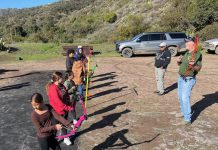Weed whacking, road patching and trail building don’t sound like fun vacation activities.
But they are for Phillip Dukes, a high school teacher from Tucson who volunteers to spend his vacations performing these tasks and much more for the Catalina Island Conservancy.
Dukes has volunteered on the Island once or twice every year for the last four years, and he said there’s no better way to spend a holiday.
Weed whacking, road patching and trail building don’t sound like fun vacation activities.
But they are for Phillip Dukes, a high school teacher from Tucson who volunteers to spend his vacations performing these tasks and much more for the Catalina Island Conservancy.
Dukes has volunteered on the Island once or twice every year for the last four years, and he said there’s no better way to spend a holiday.
“It’s extremely fun, so even though you’re working part of the time that you’re visiting the Island, it doesn’t feel like work,” he said. “It feels like a total vacation.”
Dukes is one of the more than 900 Catalina Island Conservancy volunteers who donate over 24,000 hours a year to comb the windward beaches for trash, maintain wildlands trails and fix fences.
They help with driving, office work, invasive plant removal, native plant restoration, maintenance work, biologists’ studies, marathons and other events.
“We work with individuals and groups to match their skills and abilities with positions or projects that will best satisfy their interests and aid in the fulfillment of the Conservancy’s mission,” said Lesly Lieberman, Conservancy volunteer coordinator.
“With Phillip, it’s easy to find a job because he embraces just about any task we have and does it with great enthusiasm,” said Lieberman.
Dukes first came to Catalina in 2012 as a member of AmeriCorps, the national service program that provides teams of volunteers to the Conservancy for several weeks every year.
He said the beauty of the Island, the important work of the Conservancy and the support of Lieberman and Cindy Lazaris, the Conservancy’s volunteer coordinators at the time, “just blew me away. It was just like in a dream world. I couldn’t believe how lucky we were to be partnered with the Conservancy.”
“The second we left Catalina, our AmeriCorps team began scheming how we were going to come back because we realized the Island is a really special, once-in-a-lifetime place,” Dukes said. “All of us had fallen in love with it.”
After completing his volunteer service with AmeriCorps, Dukes and some of his former AmeriCorps teammates enjoyed reuniting on the Island in 2012, 2013 and 2014 to volunteer at the Conservancy Ball and the Catalina Island Film Festival. They also worked on trail restoration and other maintenance projects.
“It was just a total dream vacation to come back and work with those guys and see all our friends,” Dukes said.
This past summer, he introduced the next generation to Catalina conservation and volunteering.
Dukes is a “Big Brother,” through the Big Brother mentoring program, and he brought his “Little Brother,” a 17-year-old mentee, Robert Robles, with him to the Island for a week-long volunteer vacation.
They helped the Conservancy’s facilities crew and worked on several different projects. They also enjoyed ocean swims, hikes and other recreation.
“It was just such a meaningful experience because the work the Conservancy does is just so special,” Dukes said. “For Robert to get a chance to be a part of this amazing organization and just see this very special place is extraordinary.”
If you are interested in volunteering with the Catalina Island Conservancy, please contact Lesly Lieberman, Volunteer Coordinator, 310-510-2595 ext. 112, llieberman@CatalinaConservancy.org. Or visit the “Volunteer” page on the website, CatalinaConservancy.org.
About the Catalina
Island Conservancy
Formed in 1972, the Catalina Island Conservancy is one of California’s oldest land trusts. Its mission is to be a responsible steward of its lands through a balance of conservation, education and recreation.
Through its ongoing efforts, the Conservancy protects the magnificent natural and cultural heritage of Santa Catalina Island, stewarding approximately 42,000 acres of land and more than 60 miles of rugged shoreline.
It provides an airport and 50 miles of biking and nearly 150 miles of hiking opportunities within its road and trail system.
The Conservancy conducts educational outreach through two nature centers, its Wrigley Memorial & Botanic Garden and guided experiences in the Island’s rugged interior.
Twenty miles from the mainland, the Island is a treasure trove of historical and archaeological sites.
It also contains numerous rare and endangered animals and plants.
The Island is home to 60 species – and counting – that are found only on Catalina. For additional information, please visit www.catalinaconservancy.org.











